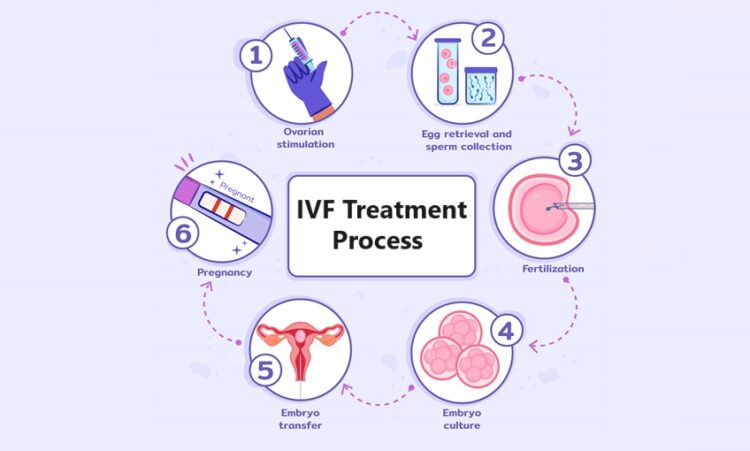Bringing new life into the world is a beautiful and profound journey, but for some, it can be a challenging one. In vitro fertilization (IVF) is a groundbreaking medical procedure that has enabled countless couples to overcome infertility and realize their dream of parenthood. In this comprehensive guide, we will walk you through the IVF treatment process step by step, providing insights into what IVF is, when it’s recommended, the associated costs, and success rates, as well as addressing some common FAQs.
What is IVF?
IVF, or in vitro fertilization, is a fertility treatment method that involves fertilizing an egg with sperm outside the body in a laboratory. Once fertilized, the embryo is then transferred into the uterus for implantation, with the goal of achieving a successful pregnancy. IVF is a ray of hope for couples who have been struggling with infertility due to various medical conditions.
The IVF Process: A Step-by-Step Guide
- Ovulation Induction: The journey begins with the administration of fertility medications to stimulate the ovaries to produce multiple eggs. Regular monitoring through ultrasounds and blood tests is vital during this phase.
- Egg Retrieval: When the eggs are mature, a minor surgical procedure called egg retrieval is performed. It involves using a thin needle to extract the eggs from the ovaries. This step is usually performed under sedation or light anesthesia.
- Sperm Collection: Around the same time as egg retrieval, a sperm sample is collected from the male partner or a sperm donor.
- Fertilization: In the laboratory, eggs and sperm are combined to facilitate fertilization. This can occur through traditional insemination, where sperm is placed near the egg, or through intracytoplasmic sperm injection (ICSI), where a single sperm is injected directly into an egg.
- Embryo Culturing: Fertilized eggs develop into embryos over the next few days. Skilled embryologists monitor their progress, assessing their quality and development.
- Embryo Transfer: Typically, after 3-5 days, one or more healthy embryos are chosen for transfer. The selected embryos are carefully placed in the uterus through a thin catheter. This step is usually painless and does not require anesthesia.
- Luteal Phase Support: To enhance the chances of implantation and a successful pregnancy, hormonal support is provided to the woman through medications like progesterone.
- Pregnancy Test: Approximately 10-14 days after the embryo transfer, a blood test is performed to determine if the procedure was successful and if pregnancy has occurred.
What is the Cost of IVF?
The cost of IVF can vary widely depending on factors such as the clinic, location, the specific treatment protocol, and any additional procedures required. In general, the cost includes medications, monitoring, egg retrieval, laboratory services, and embryo transfer. It’s essential to discuss the costs with your chosen clinic and inquire about any financing or insurance options that may be available.
When is IVF Recommended?
IVF may be recommended for couples who have experienced infertility for a significant period or those with specific conditions like tubal blockages, severe male infertility factor, or unexplained infertility. Additionally, it can be an option for single individuals or same-sex couples who want to build a family.
When determining the ideal centre for your IVF journey, here are some crucial factors to consider:
- Professional Expertise: Look for a centre with a team of highly experienced fertility specialists. Their expertise can greatly influence the success of your IVF treatment.
- State-of-the-Art Technology: Cutting-edge technology and modern laboratory facilities are essential for successful IVF procedures. Ensure the center you choose is equipped with the latest advancements in reproductive medicine.
- Patient-Centric Approach: A supportive and compassionate staff can make your IVF journey more comfortable. Seek a center that prioritizes patient care and provides emotional support throughout the process.
- Proven Track Record: Investigate the center’s success rates. Centres with a strong history of successful outcomes are more likely to provide you with the best chance of achieving your desired result.
By carefully evaluating these factors, you can make an informed decision about the right center to entrust with your IVF treatment.
What Are IVF Success Rates?
IVF success rates are subject to variation based on individual factors. Key variables such as age, overall health, and the specific causes of infertility can significantly impact the outcome of the procedure. It’s imperative to work closely with your healthcare team to evaluate your distinctive circumstances and develop a customized treatment plan that maximizes your chances of success.
IVF FAQs
- Is IVF painful? IVF is generally not painful, though some discomfort may be experienced during egg retrieval. Anaesthesia or sedation is used to minimize any discomfort.
- Are there any risks with IVF? While IVF is generally safe, there are some potential risks, including multiple pregnancies and ovarian hyperstimulation syndrome (OHSS). Your medical team will carefully monitor your progress to minimize these risks.
- How many IVF cycles are typically needed? The number of cycles required can vary widely. Some individuals achieve success in one cycle, while others may require multiple attempts.
- Is there an age limit for IVF? While there is no strict age limit, success rates decline as a woman gets older. The availability of IVF is also influenced by local regulations and clinic policies.
Conclusion
Embarking on the IVF journey is a significant step towards fulfilling your dream of parenthood. Understanding the IVF process, associated costs, success rates, and potential challenges can help you make informed decisions. If you’re considering IVF, reach out to a reputable fertility clinic for personalized guidance and support as you take the next steps toward building your family.












